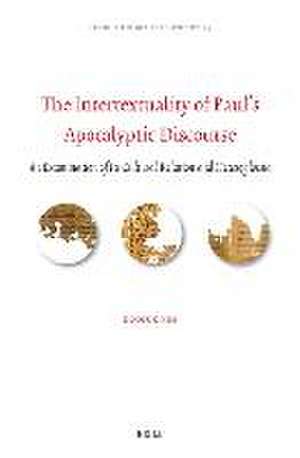The Intertextuality of Paul’s Apocalyptic Discourse: An Examination of Its Cultural Relation and Heteroglossia: Linguistic Biblical Studies, cartea 24
Autor Doosuk Kimen Limba Engleză Hardback – 17 mai 2023
Din seria Linguistic Biblical Studies
- 18%
 Preț: 850.65 lei
Preț: 850.65 lei - 18%
 Preț: 1058.03 lei
Preț: 1058.03 lei - 18%
 Preț: 1045.94 lei
Preț: 1045.94 lei - 18%
 Preț: 724.12 lei
Preț: 724.12 lei - 18%
 Preț: 875.67 lei
Preț: 875.67 lei - 18%
 Preț: 1089.95 lei
Preț: 1089.95 lei - 18%
 Preț: 798.28 lei
Preț: 798.28 lei - 18%
 Preț: 776.92 lei
Preț: 776.92 lei - 18%
 Preț: 635.13 lei
Preț: 635.13 lei - 18%
 Preț: 877.38 lei
Preț: 877.38 lei - 18%
 Preț: 1000.98 lei
Preț: 1000.98 lei - 18%
 Preț: 803.22 lei
Preț: 803.22 lei - 18%
 Preț: 1002.21 lei
Preț: 1002.21 lei - 18%
 Preț: 630.83 lei
Preț: 630.83 lei - 18%
 Preț: 941.61 lei
Preț: 941.61 lei - 18%
 Preț: 865.63 lei
Preț: 865.63 lei - 18%
 Preț: 630.05 lei
Preț: 630.05 lei - 18%
 Preț: 605.71 lei
Preț: 605.71 lei - 18%
 Preț: 632.38 lei
Preț: 632.38 lei
Preț: 951.53 lei
Preț vechi: 1160.41 lei
-18% Nou
Puncte Express: 1427
Preț estimativ în valută:
182.07€ • 189.73$ • 150.76£
182.07€ • 189.73$ • 150.76£
Carte indisponibilă temporar
Doresc să fiu notificat când acest titlu va fi disponibil:
Se trimite...
Preluare comenzi: 021 569.72.76
Specificații
ISBN-13: 9789004546271
ISBN-10: 9004546278
Dimensiuni: 155 x 235 mm
Greutate: 0 kg
Editura: Brill
Colecția Brill
Seria Linguistic Biblical Studies
ISBN-10: 9004546278
Dimensiuni: 155 x 235 mm
Greutate: 0 kg
Editura: Brill
Colecția Brill
Seria Linguistic Biblical Studies
Notă biografică
Doosuk Kim, Ph.D. (2022), McMaster Divinity College, is a lecturer at Hanam University and Seoul Bible Graduate School of Theology in South Korea. He has published articles, including “Intertextuality and New Testament Studies” (2022 CBR), and presented papers at SBL and ETS. His main academic interests and expertise include New Testament and linguistics, Apocalyptic Paul, Intertextuality, Paul and Judaism, Discourse Analysis, among others.
Cuprins
Acknowledgements
List of Figures and Tables
AbbreviationsI
1 An Introduction to Apocalyptic Paul
1.1 The Elephant in the Room: What Is Apocalyptic?
1.2 Apocalyptic as a Cultural Semiotic
1.3 Investigating the Meaning of Paul’s Apocalyptic Discourse An Overview of Analytic Program
1.4 What This Book Argues
2 A Survey of Apocalyptic Paul
2.1 What Counts for Apocalyptic Paul?
2.2 Apocalyptic Eschatology
2.3 Apocalyptic as a Revelation
2.4 Apocalyptic as a Literary Genre
2.5 The Function of Apocalyptic Writings in Its Social Setting
2.6 Conclusion
3 Methodology: Intertextual Thematic Formation and Heteroglossia
3.1 Origins and Fundamental Notion of Intertextuality: Poststructuralism
3.2 A Suggestion for Poststructuralist Intertextuality
3.3 A Methodological Proposal to Intertextuality
3.4 Identifying Thematic Formations and Heteroglossia
3.5 An Example of Thematic Formation and Heteroglossia
4 Intertextuality of the Other Worldly Journey
4.1 An Overview
4.2 An Analysis of Intertextuality of the Heavenly Ascent: 1 Cor 12:1–10, 1 En 14:1–17:5, and the Poimandres
4.3 Heteroglossia in 2 Corinthians 12
4.4 Conclusion
5 Intertextuality of the Afterlife
5.1 An Overview
5.2 An Analysis of ITFs in 1 Corinthians 15, 1 Enoch, and Plato’s Phaedo
5.3 Heteroglossia in 1 Corinthians 15
5.4 Conclusion
6 Intertextuality of Sin and Evil
6.1 An Overview
6.2 An Analysis of the Intertextuality of Sin and Evil: Rom 5:12–21, Rom 7:7–25, Wisdom of Solomon, and Philo’s Opif. and Leg.
6.3 Heteroglossia in Rom 5:12–21 and 7:5–25
6.4 Conclusion
7 Intertextuality of Two Ages and Heavenly Jerusalem
7.1 An Overview
7.2 An Analysis of Intertextuality of Apocalyptic Eschatology
7.3 Heteroglossia of Paul’s Discourse
7.4 Conclusion
8 Conclusion
Bibliography
Index of Modern Authors 240
Index of Ancient Sources 245
List of Figures and Tables
AbbreviationsI
1 An Introduction to Apocalyptic Paul
1.1 The Elephant in the Room: What Is Apocalyptic?
1.2 Apocalyptic as a Cultural Semiotic
1.3 Investigating the Meaning of Paul’s Apocalyptic Discourse An Overview of Analytic Program
1.4 What This Book Argues
2 A Survey of Apocalyptic Paul
2.1 What Counts for Apocalyptic Paul?
2.2 Apocalyptic Eschatology
2.3 Apocalyptic as a Revelation
2.4 Apocalyptic as a Literary Genre
2.5 The Function of Apocalyptic Writings in Its Social Setting
2.6 Conclusion
3 Methodology: Intertextual Thematic Formation and Heteroglossia
3.1 Origins and Fundamental Notion of Intertextuality: Poststructuralism
3.2 A Suggestion for Poststructuralist Intertextuality
3.3 A Methodological Proposal to Intertextuality
3.4 Identifying Thematic Formations and Heteroglossia
3.5 An Example of Thematic Formation and Heteroglossia
4 Intertextuality of the Other Worldly Journey
4.1 An Overview
4.2 An Analysis of Intertextuality of the Heavenly Ascent: 1 Cor 12:1–10, 1 En 14:1–17:5, and the Poimandres
4.3 Heteroglossia in 2 Corinthians 12
4.4 Conclusion
5 Intertextuality of the Afterlife
5.1 An Overview
5.2 An Analysis of ITFs in 1 Corinthians 15, 1 Enoch, and Plato’s Phaedo
5.3 Heteroglossia in 1 Corinthians 15
5.4 Conclusion
6 Intertextuality of Sin and Evil
6.1 An Overview
6.2 An Analysis of the Intertextuality of Sin and Evil: Rom 5:12–21, Rom 7:7–25, Wisdom of Solomon, and Philo’s Opif. and Leg.
6.3 Heteroglossia in Rom 5:12–21 and 7:5–25
6.4 Conclusion
7 Intertextuality of Two Ages and Heavenly Jerusalem
7.1 An Overview
7.2 An Analysis of Intertextuality of Apocalyptic Eschatology
7.3 Heteroglossia of Paul’s Discourse
7.4 Conclusion
8 Conclusion
Bibliography
Index of Modern Authors 240
Index of Ancient Sources 245
